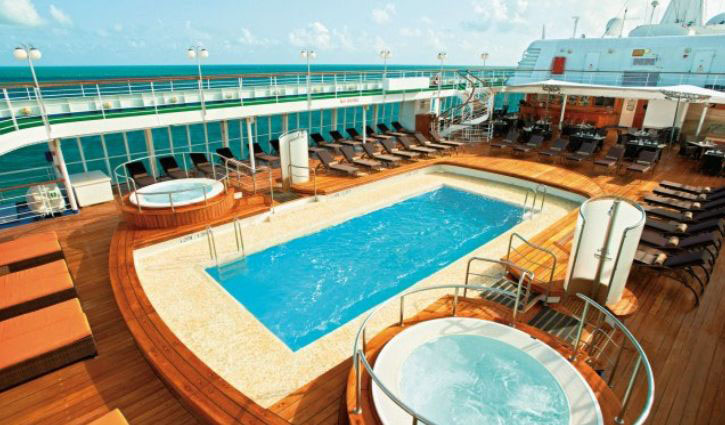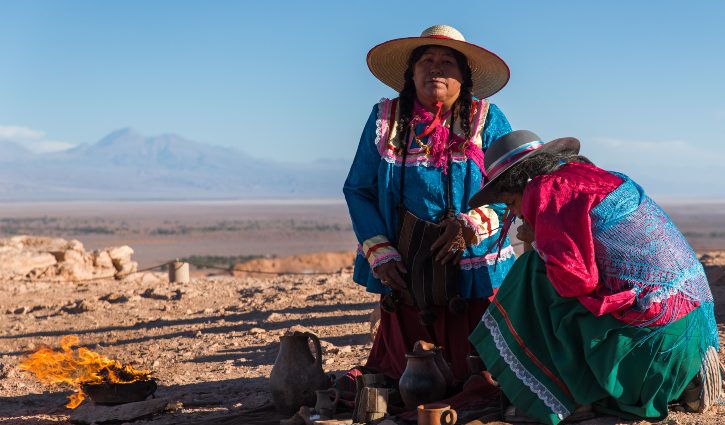
Lima to Punta Arenas
With so much to offer the curious traveller, Chile is the country that just keeps on giving. From miles of sandy coastline to beautifully preserved UNESCO World Heritage Sites to giant glaciers towering above you and huasos – Argentinian cowboys – broncobusting , there is no end to the country’s surprises. This voyage makes the most of the coast and tours the lesser known parts of this colossal country of extremes.

ITINERARY SUMMARY
DAY 1 Embark Silver Cloud, Lima, Peru

Explore Lima one of South America’s most culturally vibrant cities. With a breezy oceanfront location and a place that is rich in ancient history, colonial relics and traditional cuisine there will be plenty to do to fill your day. Embark the Silver Cloud.
DAY 2 Paracas, Peru

Paracas is blessed with magnificent natural beauty and rich historical importance, offering inviting beaches, ideal weather and pleasant scenery.The shores of the Paracas Peninsula and waters of the bay teem with wildlife and have been declared a national reserve. Condors frequently can be seen gliding on the sea winds or perched on the cliffs; pink flamingos often rest here on their migratory flights. The complex interaction between wind and ocean, sun and land has transformed this region into a kind of lunarscape under an equatorial sun. Another reason for travellers to come to this area is its proximity to the famous and mysterious Nazca Lines. Visible from the air, these strange markings stretch for miles on a large barren plain and have bewildered archaeologists, historians and mathematicians since their discovery over a century ago. The earliest Andean people found shelter here. The Paracas culture was known for fine weavings in geometrical designs and vibrant colours, which have been preserved for thousands of years by the dry climate.
DAY 3 At Sea

Days at sea are the perfect opportunity to relax, unwind and catch up with what you’ve been meaning to do. So whether that is going to the gym, visiting the spa, catching up on your reading or simply topping up your tan, these blue sea days are the perfect balance to busy days spent exploring shore side.
DAY 4 Arica, Chile

Arica boasts that it is “the land of the eternal spring,” but its temperate climate and beaches are not the only reason to visit this small city. Relax for an hour or two on the Plaza 21 de Mayo. Walk to the pier and watch the pelicans and sea lions trail the fishing boats as the afternoon’s catch comes in. Walk to the top of the Morro and imagine battles of days gone by, or wonder at the magnitude of modern shipping as Chilean goods leave the port below by container ship. Arica is gaining notice for its great surfing conditions, and in 2009 hosted the Rusty Arica Pro Surf Challenge, a qualifying event to the world series of surf.
DAYS 5 At Sea

Days at sea are the perfect opportunity to relax, unwind and catch up with what you’ve been meaning to do. So whether that is going to the gym, visiting the spa, catching up on your reading or simply topping up your tan, these blue sea days are the perfect balance to busy days spent exploring shore side.
DAY 6 Antofagasta, Chile

Situated between the ocean and the mountains of the Coastal Range is Chile’s largest city of the northern region. Antofagasta’s role as the port for the exportation of nitrate began in 1866. In 1872, when silver was discovered, the first municipality was established. Today, Antofagasta is still the centre of nitrate and copper mining, as well as an important hub for rail traffic to La Paz, Bolivia, and Salta, Argentina. According to the treaty signed after the War of the Pacific, much of Bolivia’s international commerce transits through Antofagasta. The area surrounding Antofagasta is renowned for having the highest solar intensity in the world. Its archaeological zones, desert and mountains make it a sought after place for travellers looking for unusual destinations. The city’s landscaped plazas are a tribute to man’s conquest over the desert.
DAY 7 Isla Pan De Azucar

The rugged shores of Isla Pan de Azucar (or Sugarloaf Island) are home to thousands of Humboldt Penguins. The penguins come to this arid island to breed and spend their days fishing, swimming and diving, as do many of the other birds found here. The waters around Isla Pan de Azucar also support Kelp Gulls, Blackish Oystercatchers, Peruvian Boobies, pelicans, sea lions and the reclusive South American marine otter.
DAY 8 Coquimbo, Chile

The name Coquimbo is derived from a native Diaguita word meaning ‘place of calm waters’. In fact, Charles Darwin had noted that the town was ‘remarkable for nothing but its extreme quietness’. Since then, Coquimbo has developed into a bustling port and the region’s major commercial and industrial centre from which minerals, fish products and fruits are exported. Used during the colonial period as a port for La Serena, Coquimbo attracted attention from English pirates, including Sir Francis Drake, who visited in 1578. Visitors enjoy strolling around the town, admiring some of the elaborate woodwork handcrafted on buildings by early British and American settlers. These wooden buildings are among Chile’s most interesting historical structures. Out of town, the area offers some fine beaches in a desert-like setting. Coquimbo serves as a gateway to the popular resort town of La Serena and trips farther into the Elqui Valley, known as the production centre for Chile’s national drink, pisco sour. The valley is also home to several international observatories that take advantage of the region’s exceptional atmospheric conditions.
DAY 9 Valparaiso, Chile

Disembark this morning to explore Valaparaiso, Chile’s oldest and most important seaport that’s bustling with activity. With its improvised urban design and unique architecture clinging to the hillsides, Valparaiso is a labyrinth of winding narrow streets, cobblestone alleyways and colourful hillside neighbourhoods. Continue a short distance north around the bay to Viña del Mar, the most famous and visited seaside city of the area. Its many parks with huge trees and palms have led it to being known as the “Garden City”. Also visit the beaches and the 1930s-era Casino, and learn about its history.
DAY 10 AT SEA

Days at sea are the perfect opportunity to relax, unwind and catch up with what you’ve been meaning to do. So whether that is going to the gym, visiting the spa, catching up on your reading or simply topping up your tan, these blue sea days are the perfect balance to busy days spent exploring shore side.
DAY 11 Niebla, Chile

Today you will visit Niebla, a small village on the banks of the Rio Valdivia where Chile’s Corral Bay meets the Pacific Ocean. Now Niebla is a beach resort, but in 1671 it was a defensive fortress built by the order of the Viceroy of Peru to prevent attacks against the town of Valdivia by pirates and corsairs. Niebla is well-known for its lively markets, the remains of the colonial fortress declared a National Monument in 1950 and restored in 1992, and a museum dedicated to its history. Nearby is the charming river port city of Valdivia, where cultural influences from the native Mapuche, Spanish settlers, and German immigrants have blended.
DAY 12 Puerto Montt, Chile

Today you will step off into windy Puerto Montt. For most of its history, it was the end of the line for just about everyone travelling in the Lake District. Now the Carretera Austral carries on southward, but for all intents and purposes Puerto Montt remains the region’s last significant outpost, a provincial city that is the hub of local fishing, textile, and tourist activity. Today the city center is full of malls, condos, and office towers—it’s the fastest-growing city in Chile—but away from downtown, Puerto Montt consists mainly of low clapboard houses perched above its bay, the Seno de Reloncaví. If it’s a sunny day, head east to Playa Pelluco or one of the city’s other beaches. If you’re more interested in exploring the countryside, drive along the shore for a good view of the surrounding hills.
DAY 13 Castro, Chile

Bright, wooden huts teeter on stilts over Castro’s estuary waterfront, inviting you into a patchwork of colour that’s sure to brighten any day. These traditional palafitos give the warmest of welcomes, as you prepare to experience Chile at its most vibrant. Castro has faced something of a tumultuous past, having been hit by a by a succession of earthquakes and fires – the most recent a devastating earthquake in 1960. But this city is incredibly resilient, and today the capital of Chiloe Island makes for a fantastic base for exploring the archipelago that surrounds it.
DAY 14 At Sea

Days at sea are the perfect opportunity to relax, unwind and catch up with what you’ve been meaning to do. So whether that is going to the gym, visiting the spa, catching up on your reading or simply topping up your tan, these blue sea days are the perfect balance to busy days spent exploring shore side.
DAY 15 Tortel, Chile

Tortel is a commune located in Southern Patagonia, a spectacular wilderness region of rugged mountains, glaciers, rivers and forests of infinite beauty. The uneven geography of Tortel shapes a unique landscape, characterized by an archipelagic area with numerous islands and channels. Tortel is known as the “footbridge city” for the unique beauty of its wooden walkways that connect the piers and houses of this quaint place through bridges and stairs, built from cypress wood, that run for four and a half miles around the cove and that respect the rich vegetation that grows under them. Even though it is the sixth largest commune in Chile, it has the lowest population of all with roughly 531 people.
DAY 16 Cruise the English Narrows

The English Narrows warrant time spent on the outer decks as the Captain and local Chilean Pilots expertly maneuver through the slalom course of islands and channel markers. The waterway is home to Magellanic Diving Petrels, Steamer Ducks, and the rare endemic Chilean dolphin. This small dolphin is shy of ships and enjoys spending its time in constricted straits with heavy tidal rips such as the English Narrows.
DAY 17 Cruise Chilean Fjords, Chile

Winding through the vast expanses of the Chilean Fjords will reveal mountains looming on both sides, waterfalls, and the marvel of hardy flora clinging to barren rocks. Seals and dolphins patrol the length of these uninhabited fjords as they have done for millennia. Small fishing-boats come out of Punta Arenas luring fish and trapping for king crab, while terns dip and glide coaxing their own small fish out of the deep, dark fjord waters amongst tiny islands thick with vegetation.
DAY 18 Punta Arenas, Chile

Welcome to Chile’s City at the End of The World – a wind-whipped, fractured land of islands, glacial fjords and mountains, which drop away towards Antarctica. Punta Arenas is a remote place, but with custom-free status, and more than 100,000 people calling it home it’s also surprisingly cosmopolitan. Disembark from the Silver Cloud here.


